As the temperatures from a hot summer season begin to drop, vacation rental owners are eager to know if their bookings will follow suit. The seasons may be shifting, but the peak season isn’t showing any signs of cooling down just yet. Be it vaccinations or vacations, the hope for a full recovery in 2022 has come to fruition and shows signs of reaching and, in some cases, surpassing that of 2019 numbers.
COVID-19 may still be prevalent, but stagnation in travel is seemingly disappearing, as confirmed by professionals in the vacation rental industry, such as Transparent and AirDNA. Somewhere between hype and hope, industry experts have solidly established a changing tide for travel. These rising trends are officially reinforced with our own latest internal reports and some of the findings are more than surprising.
Don’t see the form to download the Vacation Rental Industry Report? Click here.
We’ve analyzed more than 340,000 bookings and delved into the depths of the data points that indicate that the travel industry is healing. Better still, travel has returned and it’s here to stay, with off-season looking a bit different this year.
Owners can rejoice as the length of stay steadily increases
This year, we’re stretching out our vacations. After almost a year of staying at home, travelers are ready to return to what they do best: travel!
While there are still the overnighters and guests who opt for a quick getaway, we’re noticing that, on average, the number of nights booked has increased year over year, with 2021 surpassing the data from 2019. Although the average length of stay has only slightly increased, it has, nevertheless, seen a steady rise. From 2019 to September, guests have increased their length of stay by 6.2%.
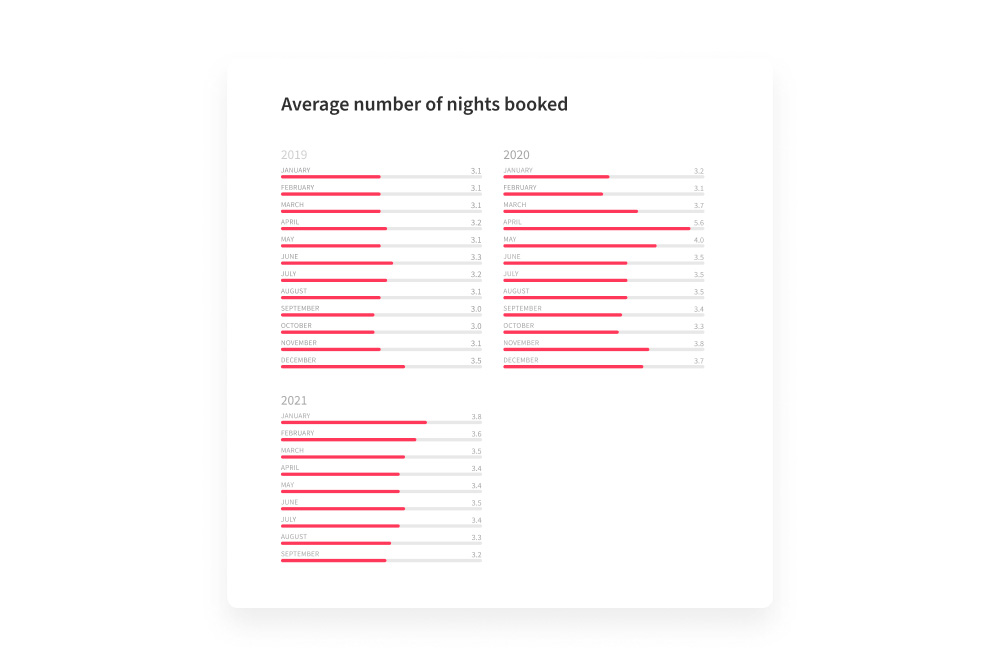
Perhaps the most interesting, while we usually see a drop in length of stay during the shoulder season, 2021 bookings have maintained their length. During the height of peak season, bookings averaged about 3.5 nights, a couple of points higher than 2019.
Transitioning into the off-season won’t be as abrupt as previous years. We’ve seen a consistent climb in the length of stay, as it rose by 5.7% in the past two last Decembers. Although the frequency of bookings is bound to cool off as we wish summer bookings adieu, the quality of the bookings, i.e. longer lengths of stay, is anticipated to be better this upcoming season.
Rural accommodations take the lead in the number of nights booked
The rising fame of rural accommodations isn’t a new phenomenon, as made apparent by the back and forth fight for first place with competing urban accommodations. The boom of cabin travel and mountainous escapes was a further indication of the shift in travel interests, but what really shines a light on this change is the length of time booked at said locations. We’ve seen the guests are staying in urban accommodations for less time and, instead, extending their holidays in these less-populated areas.
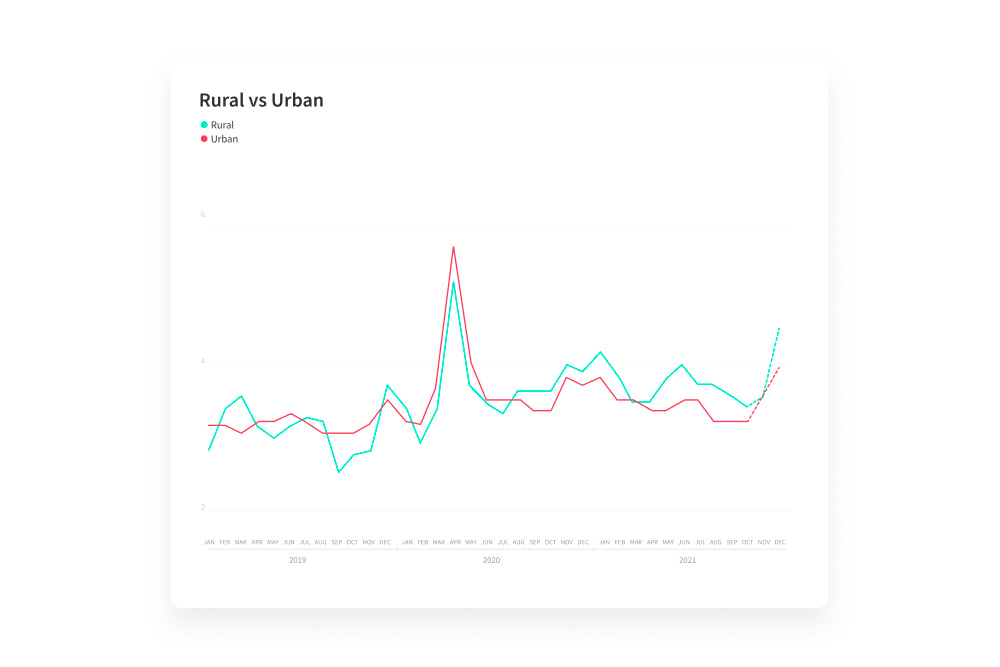
Looking at the chart, you’ll note that year after year, rural and urban were in a well-matched fight for having the longest average nights booked, continuously changing which accommodation type held first place. Rural maintained a steady ground from July 2020 to September for the length of stay. This year alone, rural accommodations held a 12% lead over urban stays in terms of the booking duration.
When comparing the high season of 2021 vs. 2020, the number of nights booked in urban accommodations decreased by 10% while rural stays continued to grow. When looking at the chart, it’s clear to see that rural accommodations have kept a firm position as their success is less dependent on COVID-19 restrictions.
Weekend warriors still champion, but mid-length stays are closing in
The makeup of your bookings consists of various traveler personas. So, where are the majority of your bookings coming from? Are you hosting the spontaneous sightseers or the agenda-loving jet setters? The reality is, despite the positive outlook on longer booking windows, most of your reservations are still going to be last-minute decisions and with a shorter length of stay.
Findings show that a little over 70% of bookings are short stays (with guests only staying 1 to 3 days) while the runner-up is bookings 4-7 days long. These mid-length stays make up 25% of all bookings from 2019 to last September.
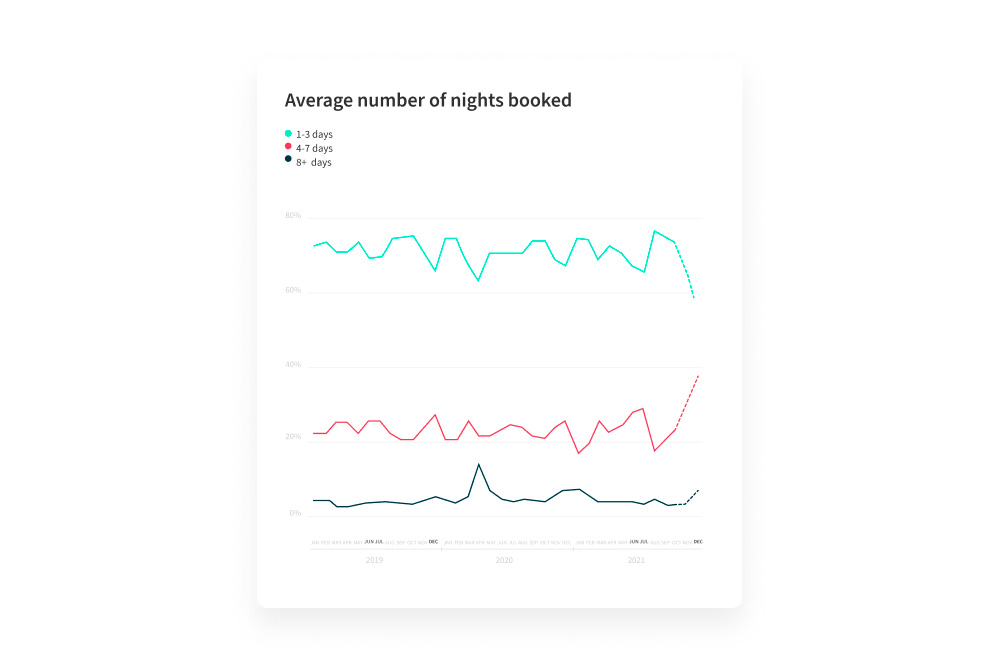
However, when we take a closer look at the data, we see that in July 2021, 4-7 day bookings rose by 30% of all bookings, a trend that seems to repeat again from September on and continuing in the late fall months.
The majority of bookings still only occupy a weekend’s length of time, but growth in mid-length stays suggests a pivot in travel trends that are attempting to break the mold of weekend-only reservations.
The longer the booking window, the longer the stay
Long-term bookings have a 25% longer length of stay compared to last-minute bookings
Your booking window isn’t just important for planning; it’s also a key indicator for gauging the length of stay. We’ve found that the more advanced the booking is made, the longer the visit will be. Let’s take your last-minute bookings as an example.
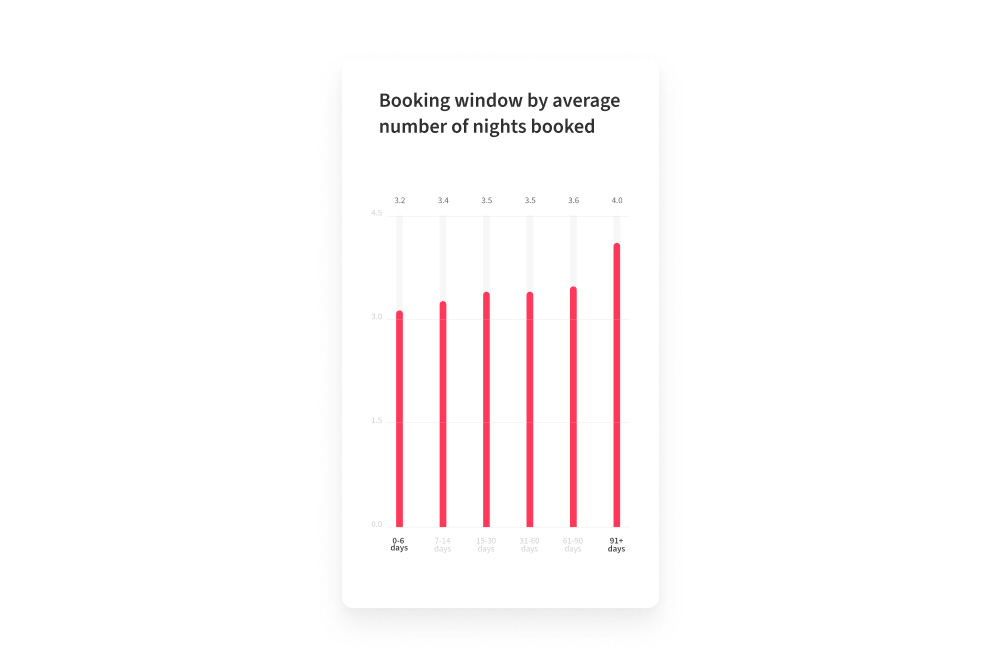
Travelers who book 0-6 days in advance stay, on average, for 3.2 days. These bookings are short and sweet without much planning required. Moving to the middle of your booking window, you’ll find the guests that reserve 15-30 days out. With only maybe a week’s more planning, they’re staying 3.5 days on average. It might not seem like much, but it represents more than a 9% increase compared to last-minute reservations.
Your most advanced planners (the ones who are booking 90+ days in advance) will stay four days on average. So by encouraging travelers to book about three months in advance, you’ll find that their bookings are going to be 25% longer than any spur of the moment plans.
South-east states hold the highest length of stay
Florida offered a safe haven for vacationers in the midst of the pandemic. After being slammed with COVID cases in the summer of 2020, Florida started to piece together a plan to help heal its tourism-dependent economy.
Last September saw a full rollback for COVID restrictions as Governor Ron DeSantis unveiled the reopening of bars and restaurants at total capacity. Entertainment was back on and spacious stays were readily available, creating a perfect storm to lure travelers in.
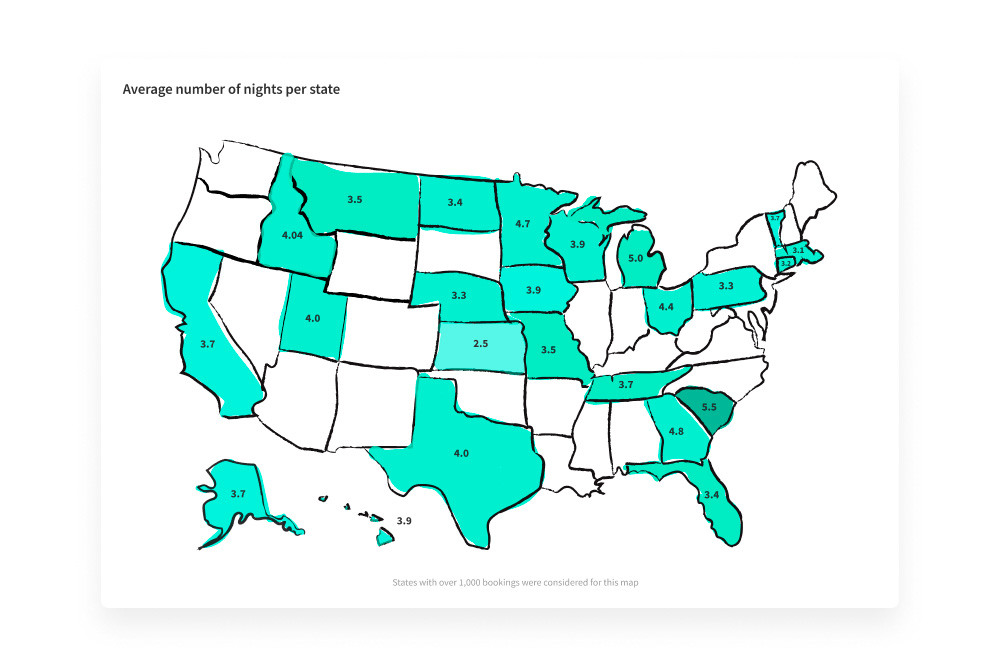
Almost a full year later, Florida is still holding strong and perhaps with permanence. With two of its cities making the list of the top US locations for vacation rental investment, Florida’s fame is becoming evident for everyone in and out of the industry. Vacation rentals in Florida have seen higher occupancy rates, generous booking windows, and a longer length of stay when compared to the country as a whole.
Luckily, Florida’s success has been contagious. Some of its surrounding states like Georgia and South Carolina have also seen a rise in length of stay.
South Carolina tops them all with an average length of stay at 5.6 nights. This means that most of the bookings they receive are there for the week rather than just a quick weekend trip. Second up is Georgia, with an average length of stay of 4.5 nights. The southern summers were a little longer than their northern counterparts this year.
Booking windows grow as guests gain confidence to plan in advance
Somewhere between your weekend warriors and your advanced planners is the average. Not everyone is deciding to travel with the snap of their fingers nor book their accommodation with one year’s notice. The average traveler falls somewhere between absolute spontaneity and extreme preparation, but how has the average shifted over time, especially in the wake of a pandemic?
The average booking window was at its highest point in 2019. January 2019 holds the record with a booking window of 58.4 days made in advance. Naturally, the booking window for 2020 dropped shortly after the start of the pandemic in March as shown by a decline of -10 days.
While a booking is still a booking, as professionals in the vacation rental industry, we all know that having advanced reservations is far superior to those off-the-cuff plans.

As vacation rental professionals, you have a better chance of properly planning out your calendar and getting a holistic view of how much revenue to anticipate when guests make reservations further than just the immediate future. Further, when you have reliably long booking windows, you know what vacancy to expect so as to market, strategize, and spend accordingly.
Fortunately, travelers are gaining confidence and the booking window is mirroring that. As we’re able to predict a little better about what the near future looks like, vacations start to look a little more realistic. We see the booking window inch along as restrictions loosen and travelers re-embark on adventures.
Most notably, August and September held a relatively high booking window of 27.3 days and 23.7 days made in advance. In normal years, these are the months that typically see a cooldown of advanced bookings, but 2021’s shoulder season was almost back to 2019’s standard of advanced bookings.
Ohio, Florida and California, with the largest booking window
The great East Coast versus West Coast face-off came to a head when we analyzed the booking window.
Surprisingly, this is where frontrunners, Florida and California, found their equals. Florida had an average booking window of 44.7 days in advance, while California was close behind with a booking window of 41.1. Notably, and perhaps unexpectedly, Ohio had the longest booking window out of the entire country, with an average of 49.2 days.
Rural accommodation’s occupancy rates rise, but urban still holds the lead
Perhaps unsurprising, rural accommodations came out ahead in the post-pandemic sphere. Urban accommodations have long dominated the industry as tourism concentrates in cities. As interest turned away from the metropolitan norm, we witnessed a substantial growth of 31% when comparing the first half of 2019 to the first half of 2021.
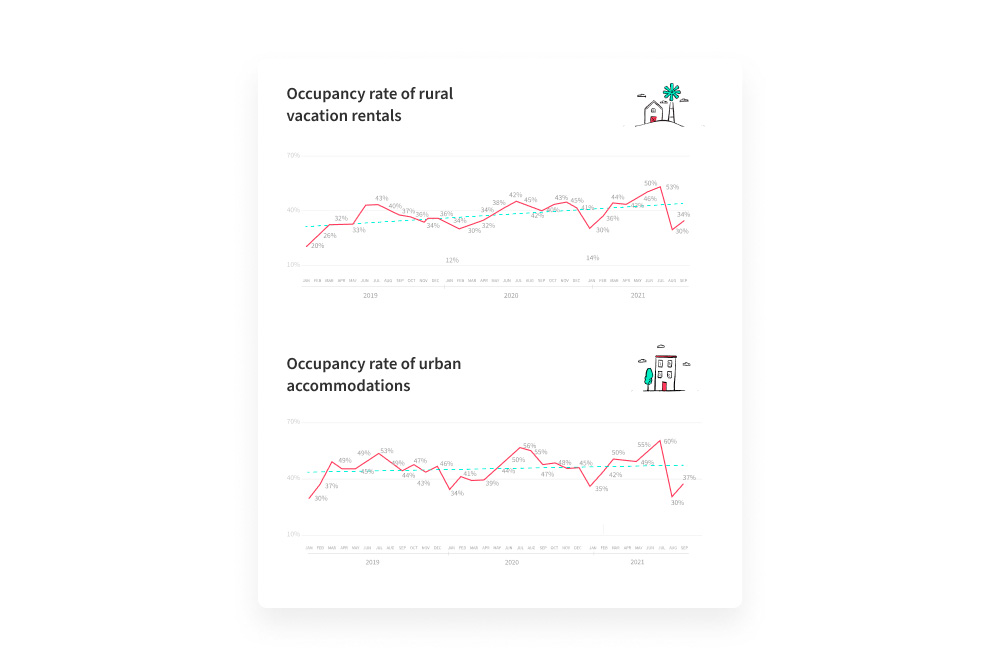
A cluster of big cities in the north such as New York City, Washington D.C., Chicago, and Philadelphia saw an exodus of citizens as “going off the grid,” and remote work became more and more enticing during the pandemic. Rather than being crammed and locked down in these busy, blustery cities, many people sought refuge in the more rural corners of the United States.
Still, urban accommodations experienced their highest occupancy rate in the last two years in July 2021, reaching a sizeable 60%. This is to say that, although rural accommodations are gaining traction, urban stays still have maintained a considerably high occupancy rate over the three-year span.
Vacation rentals flex their value as ADR continues to climb every year
Vacation rentals are no longer simply the hotel alternative but are now a more desirable option for travel. As the world turns towards authentic experiences and off-beat stays, vacation rentals offer an incredible stand-in for unique places to stay. Short-term rentals are gaining popularity over hotels, as indicated by a rising average daily rate (ADR). The value of a night spent at a vacation rental is growing as its popularity scales.
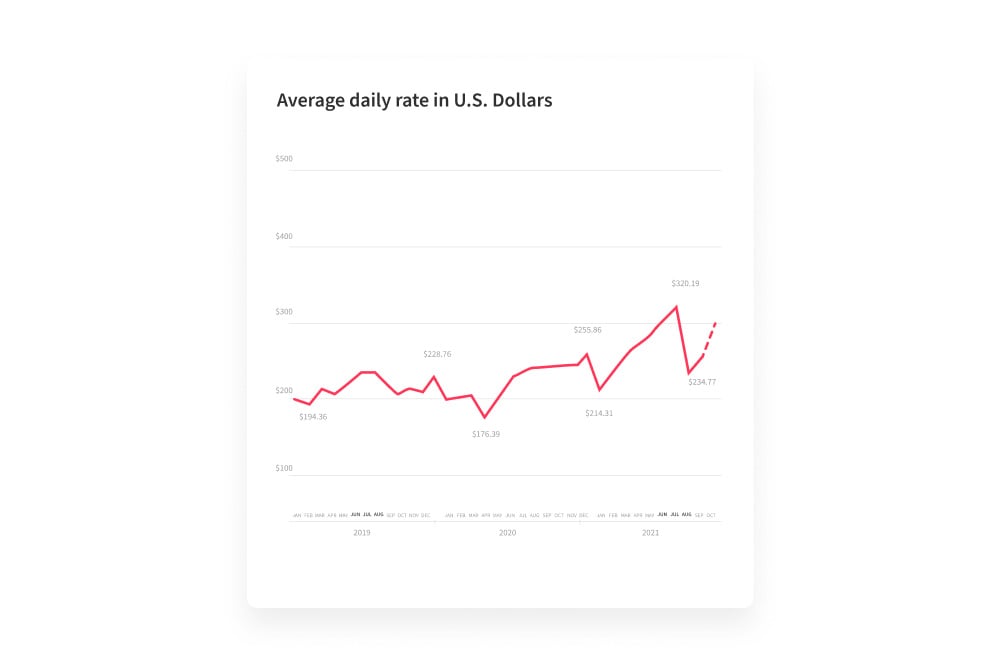
Just within the most recent summer months, the average daily rate climbed a steady 30% increase from June to August compared to the same months in 2019. This jump in rates can be attributed to their rising fame and a safe, sanitary solution to travel during COVID-19.
Building a game plan for the upcoming season
The facts and figures are in; now how are you going to carry this into your next season? Some vacation rental owners saw a grand slam of a return this past summer, while others are gearing up for a promising winter.
In any case, owners everywhere are hoping to extend their profits into the upcoming season. Knowing what we know, we’ve got some tips to follow this fall for your vacation rental business.
1. Rural stays should play the long game
One of the many successes for rural accommodations in 2021 was their ability to attract travelers with a longer stay than the pre-COVID usual. The guests who did book these rustic retreats tended to stay for a longer period of time than those who travel to urban destinations. Not only did rural travelers stay for longer, but they also booked these accommodations further in advance than their urban counterparts.
With those two facts in mind, rural vacation rental owners can market their property accordingly. Offering early-bird specials and rewarding longer stays with discounted rates will encourage travelers to book further in advance and for an extended period of time.
Consider too the type of audience that’s headed for the countryside. Remote workers and digital nomads are going to want to stay for at least the duration of their workweek, so factor them in too when strategizing your sales and promo codes. Ensure your home is well-equipped for “e-ployees” and digital nomads by adding working essentials like high-speed internet and an ergonomic desk and chair.
Families that were pent up in an urban apartment might want some wide-open space to stretch their legs and let the kids spread out. Large family discounts will help to draw in these crowds. Amenities, too, are a big allure for families! Even small comforts such as board games and subscription services like Disney Plus will help to draw in your familial target audience.
2. Urban accommodations need to break away from the weekend rut
City stays might have hit a lull, but that doesn’t mean there’s not still room for redemption during the off-season. Most urban accommodations were faced with short stays this past summer season, meaning high guest turnover, more work, and labor expenses. Longer reservations are ideal and still entirely possible as we transition into the cooler months. To play catch up to rural accommodations, owners will have to find a way to entice their guests to stay a little longer.
Having segmented discounts for longer stays, such as 20% off seven days, 25% off ten days, and 30% off fourteen-day stays will encourage guests to stay longer. Make sure you calculate what the true cost of guest turnover would be so as to not offer a discount that negatively impacts your income.
Minimum stays, although controversial at times, also help to enforce a longer stay. You might want to consider having a three-night minimum stay listed on your website and listings with exceptions only made upon request. The downside of this is risking losing out on potential bookings. Make sure you’ve thoroughly evaluated demand before risking your short-term bookings in exchange for hopes of longer stays.
3. The holiday booking window is now
Reservations for Thanksgiving, December holidays, and New Year’s are being made now. If your reservation calendar isn’t up to your satisfaction for the holiday season at this point, it’s time to consider building a vacation rental marketing plan. With Black Friday just around the corner, you’ll have the perfect promotion opportunity to advertise your property and bring in more guests.
Running paid digital ads, reaching out to previous guests, and offering holiday promotional codes for those who book before October will help you fill your calendar to your liking and eliminate vacancies.
With that said, last-minute bookings aren’t completely out of the question. If you’re hoping for a packed holiday season, you can still reel in new bookings from now all the way to New Year’s Eve. Remember, that there’s still a large chunk of traveler’s booking last minute or only a week out. Target the spontaneous by running promotions for last-minute deals or adjust your pricing at the start of December.
Takeaways
The future is bright and the bookings are brighter. The vacation rental industry is recovering steadily, as shown through an improved booking window, longer lengths of stay, and a better outlook for urban accommodations.
This potential for reservations means you’re going to need a set of tools equipped to help you manage your bookings. Lodgify’s vacation rental software allows you to implement all these strategies, oversee your reservations, keep track of your calendar and grow your business. Maintaining your bookings both on and off-season can be a challenge, which is why your business needs software that can help you to get the job done. Scale your business by applying our findings and implementing property management software that strives to bring you success and manage your reservations with ease.
We’ve seen the rush of revenge travel start to taper off, the summer season return to near normalcy, and a decent shoulder season. Nevertheless, some markers are still yet to return to their pre-COVID numbers, such as urban accommodation occupancy rates and advanced reservations.
Counter the lower occupancy rates by using your vacation rental website to highlight what your accommodation has to offer, such as a captivating amenities tab or virtual tour embedded on your home page, to get your numbers back to pre-COVID rates.
With all the knowledge at hand, owners need to be ready for the season ahead as summer comes to its full close. Shorter bookings and last-minute reservations are in the air, but that doesn’t mean they have to be deemed a negative. Dynamic pricing will allow you to counter the shorter reservation times, while promotional codes can encourage the clientele you’re seeking.
Don’t go into the season ahead blindly. Prepare your business by investing in new vacation rental software to streamline your operations. The right software will help you manage your calendars, bookings and payments for all your vacation rentals. And make sure it comes with a channel manager integrated with the top-leading OTAs, reservation system, and a fully-functioning website builder to make the most of the upcoming winter season.
Infographic: U.S. Short Term Rental Trends 2021
Click on the infographic to zoom
If you’d like to share this infographic on your site, simply embed the following code and include an attribution to Lodgify:
Methodology
To deliver the most accurate findings, all data points were pulled from the Lodgify database, from different states, taking into account both rural and urban, as well as types of accommodation, enabling a statistically valid approach reassured by descriptive analysis, outlier analysis, histograms and more.
This study was done with a random sampling of over 300,000 in-house reservations from across the United States – whether they were direct bookings or from Airbnb, Vrbo, Booking.com or Expedia. They occurred between January 2019 to September 2021, which helped us understand the impact of COVID-19 as well as the before/after of the pandemic.



